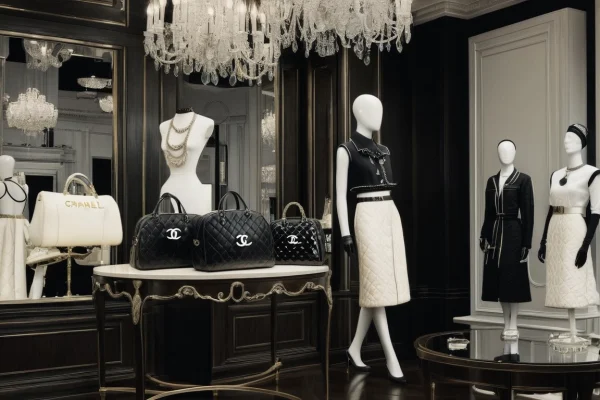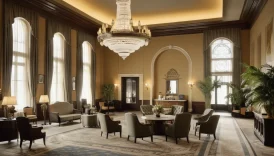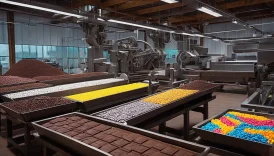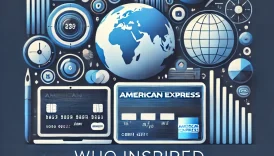Who Inspired the Evolution of Chanel?

- Who Inspired the Evolution of Chanel?
- Coco Chanel: The Visionary Founder
- The Influence of Art and Culture
- Surrealism and Fashion
- The Role of the Ballets Russes
- Art Deco's Impact
- Literary Influences on Chanel
- Collaborations with Artists
- Fashion Meets Fine Art
- Influence of Other Designers
- Frequently Asked Questions
The iconic fashion brand Chanel has a rich history that is deeply intertwined with the visionary ideas and cultural contexts of its time. Founded by the remarkable Coco Chanel, the brand has evolved through various influences that have shaped not only its aesthetic but also its philosophy. From the revolutionary spirit of its founder to the artistic movements of the early 20th century, Chanel’s evolution is a tapestry woven with creativity, rebellion, and innovation.
Coco Chanel’s journey began in a world where women’s fashion was constrained by the norms of the day. With her bold approach, she challenged the status quo, introducing designs that emphasized elegance and simplicity. This was not just fashion; it was a statement of freedom for women everywhere. As she famously said, “Fashion is not something that exists in dresses only. Fashion is in the sky, in the street, fashion has to do with ideas, the way we live, what is happening.” This quote encapsulates the essence of Chanel’s vision and her profound impact on the fashion industry.
The evolution of Chanel also reflects the influence of various artistic movements. The early 20th century was a time of great change, with movements such as Cubism and Surrealism reshaping the cultural landscape. These artistic styles encouraged Chanel to explore new dimensions in her designs, allowing her to blend the boundaries between art and fashion. For instance, the Ballets Russes introduced vibrant colors and theatrical elements that became integral to her collections, while the Art Deco movement brought geometric patterns and luxurious materials that resonated with the modern woman of the 1920s.
Moreover, Chanel’s collaborations with renowned artists like Pablo Picasso and Salvador Dalí further enriched her brand’s identity. These partnerships not only enhanced her creative vision but also showcased her ability to merge fashion with fine art, creating pieces that transcended traditional boundaries. The interplay of these influences illustrates how Chanel was not merely a designer; she was a cultural icon who understood the pulse of her time.
| Influence | Description |
|---|---|
| Coco Chanel | Revolutionized women’s fashion with simplicity and elegance. |
| Ballets Russes | Introduced vibrant colors and theatrical elements to her designs. |
| Art Deco | Influenced her use of geometric patterns and luxurious materials. |
| Surrealism | Encouraged exploration of unconventional shapes and materials. |
In conclusion, the evolution of Chanel is a fascinating journey that highlights the interplay of art, culture, and personal vision. As we delve deeper into the influences that shaped this legendary brand, we uncover a story of innovation, rebellion, and the relentless pursuit of beauty.
Coco Chanel: The Visionary Founder
Coco Chanel was not just a fashion designer; she was a revolutionary force who changed the landscape of women’s fashion forever. Born in 1883 in Saumur, France, her journey from humble beginnings to becoming a style icon is nothing short of inspiring. Chanel’s innovative spirit and rebellious nature challenged the norms of her time, allowing women to embrace a new sense of freedom and identity.
In the early 20th century, women were often confined to restrictive clothing that emphasized their femininity in traditional ways. Chanel, however, had a different vision. She believed that fashion should be comfortable and practical while still being elegant. Her designs emphasized simplicity, featuring clean lines and a minimalist aesthetic that paved the way for modern femininity. This was a bold statement in an era when corsets and elaborate gowns dominated the fashion scene.
Chanel’s most iconic creation, the Chanel No. 5 perfume, exemplifies her forward-thinking approach. Launched in 1921, it was one of the first fragrances to become a fashion statement in its own right. The combination of its unique scent and the elegant bottle design made it a symbol of luxury and sophistication. To this day, it remains a bestseller, proving that Chanel’s vision was not only ahead of her time but also timeless.
| Chanel’s Key Contributions | Description |
|---|---|
| Little Black Dress | A versatile wardrobe staple that redefined women’s fashion. |
| Chanel Suit | A tailored suit that combined comfort with elegance, symbolizing women’s empowerment. |
| Costume Jewelry | Making luxury accessible, Chanel popularized the use of costume jewelry in high fashion. |
Chanel once said, “Fashion is not something that exists in dresses only. Fashion is in the sky, in the street, fashion has to do with ideas, the way we live, what is happening.” This quote encapsulates her belief that fashion is an expression of one’s identity and the changing times. Her legacy continues to inspire countless designers and fashion enthusiasts around the world.
In conclusion, Coco Chanel was a visionary founder whose influence transcended the realm of fashion. Her ability to blend practicality with elegance not only changed how women dressed but also how they perceived themselves. Today, we celebrate her as a pioneering force in modern fashion, a true icon whose impact is felt even decades after her passing.
The Influence of Art and Culture
The evolution of Chanel is deeply intertwined with the art and cultural movements that flourished in the early 20th century. These movements not only influenced Coco Chanel’s designs but also helped redefine the very essence of fashion. When you think about it, fashion is much like art; it reflects the social fabric of its time. Chanel’s ability to absorb and reinterpret these influences made her a true pioneer in the industry.
One of the most significant influences on Chanel was the Surrealism movement. This artistic style, characterized by its dreamlike and bizarre imagery, encouraged Chanel to break away from conventional design norms. Imagine a world where clothing isn’t just functional but also a form of self-expression—this was the essence of Surrealism. It allowed Chanel to experiment with unconventional shapes and materials, resulting in designs that were not only innovative but also provocative.
| Art Movement | Influence on Chanel |
|---|---|
| Surrealism | Encouraged exploration of unconventional shapes and materials. |
| Art Deco | Introduced geometric patterns and luxurious materials. |
| Ballets Russes | Inspired vibrant colors and theatrical design motifs. |
Another major influence was the Art Deco movement, known for its geometric patterns and luxurious materials. Chanel embraced these elements, integrating them into her collections to emphasize modernity and sophistication. The way she utilized these artistic styles reflected her vision for the evolving woman of the 1920s—bold, confident, and unafraid to express herself.
Moreover, the Ballets Russes, a revolutionary ballet company, also played a crucial role in shaping Chanel’s aesthetic. Their vibrant colors and theatrical presentations inspired her to incorporate a sense of drama into her designs. This collaboration showcased how fashion and performance art could seamlessly intersect, highlighting Chanel’s flair for dramatic elegance.
In summary, Chanel’s designs were not created in a vacuum. They were a response to the dynamic art and cultural landscape of her time. By drawing inspiration from these movements, she was able to craft a fashion legacy that continues to influence designers today. Just like a painter uses a palette of colors, Chanel used her cultural influences to create a masterpiece that redefined women’s fashion.
Surrealism and Fashion
Surrealism, with its dreamlike qualities and emphasis on the subconscious, played a pivotal role in shaping the world of fashion, particularly for Chanel. Imagine stepping into a realm where the boundaries of reality blur, where garments become canvases for artistic expression. This was the essence of Surrealism, and it profoundly influenced Chanel’s creative process. It encouraged her to explore unconventional shapes and materials, leading to designs that were not just clothing but a fusion of art and fashion.
One of the most striking aspects of Surrealism is its ability to evoke emotion through unexpected juxtapositions. Chanel embraced this concept, creating pieces that challenged traditional notions of beauty and functionality. For instance, her use of asymmetrical cuts and unexpected fabric combinations mirrored the surrealists’ penchant for the bizarre. Her designs often featured elements that seemed to defy logic, yet they resonated deeply with the modern woman seeking to express her individuality.
To illustrate the impact of Surrealism on Chanel’s work, consider the following table that highlights key elements of Surrealism and their manifestation in her fashion designs:
| Surrealism Element | Chanel’s Fashion Interpretation |
|---|---|
| Dreamlike Imagery | Flowing silhouettes that evoke a sense of freedom |
| Unexpected Combinations | Mixing luxurious fabrics with utilitarian designs |
| Emphasis on the Subconscious | Designs that reflect personal identity and emotional depth |
Chanel’s fearless approach to fashion allowed her to transcend the ordinary. She didn’t just create clothes; she crafted visual narratives that invited the wearer to step into a new reality. This connection between Surrealism and fashion was not merely aesthetic; it was a cultural commentary on the evolving role of women in society. Just as surrealists sought to unlock the mysteries of the mind, Chanel aimed to liberate women from the confines of traditional fashion.
In conclusion, the influence of Surrealism on Chanel’s designs was profound, encouraging her to break free from convention and embrace a world of imagination. Her work remains a testament to the power of art in shaping fashion, inspiring generations to explore their own creativity and individuality.
The Role of the Ballets Russes
The Ballets Russes was not just a dance company; it was a cultural phenomenon that reshaped the artistic landscape of the early 20th century. Founded by Sergei Diaghilev in 1909, this ballet company brought together a stunning array of artists, musicians, and designers, creating a vibrant tapestry of creativity that would profoundly influence Chanel’s fashion designs. The collaboration between fashion and performance art opened new avenues for expression, allowing Chanel to draw inspiration from the dramatic flair and vivid colors of the ballet.
Chanel’s admiration for the Ballets Russes is evident in her use of bold color palettes and theatrical motifs. The company’s performances were a feast for the senses, featuring elaborate costumes and sets that captivated audiences. This artistic synergy inspired Chanel to incorporate similar elements into her collections, leading to a unique style that blended elegance with the theatricality of the stage.
| Influence | Chanel’s Response |
|---|---|
| Vibrant Colors | Adoption of bold hues in her collections |
| Theatrical Designs | Incorporation of dramatic silhouettes and embellishments |
| Artistic Collaboration | Partnerships with artists for unique pieces |
Chanel’s work with the Ballets Russes was not just about aesthetics; it was a collaboration that redefined fashion. By merging the worlds of dance and haute couture, she created a new narrative for women’s fashion, one that celebrated movement and grace. This intersection of art and fashion allowed her to express a modern femininity that resonated with the changing roles of women in society.
In essence, the Ballets Russes played a pivotal role in Chanel’s evolution as a designer. The influence of this groundbreaking company can still be seen in her collections today, where the spirit of performance art continues to inspire creativity and innovation. So, the next time you admire a Chanel piece, remember the vibrant legacy of the Ballets Russes that helped to shape it!
Art Deco’s Impact
The Art Deco movement emerged in the 1920s as a symbol of modernity and luxury, profoundly influencing the fashion landscape, particularly Chanel’s designs. Characterized by bold geometric patterns, vibrant colors, and opulent materials, Art Deco resonated with Coco Chanel’s vision of the evolving woman. Chanel embraced this style, incorporating its elements into her collections to create garments that were not just clothing but statements of sophistication and elegance.
Imagine walking through a bustling city in the 1920s, where skyscrapers gleamed with angular designs and the streets buzzed with the energy of a new era. This was the world that inspired Chanel, as she sought to reflect the dynamism of modern life in her work. The Art Deco aesthetic allowed her to push boundaries, merging art with fashion in a way that was both innovative and captivating.
| Art Deco Characteristics | Chanel’s Adaptations |
|---|---|
| Geometric Patterns | Incorporated into fabrics and silhouettes |
| Luxurious Materials | Used silk, satin, and beading to enhance elegance |
| Vibrant Colors | Experimented with bold color palettes |
Chanel’s ability to blend the Art Deco style with her own unique flair is evident in her iconic pieces. For instance, the use of black and gold became a hallmark of her collections, symbolizing both luxury and modernity. This combination not only set trends but also established Chanel as a leader in the fashion industry.
Moreover, the influence of Art Deco extended beyond mere aesthetics. It represented a cultural shift towards freedom and expression, mirroring the societal changes of the time. Women were stepping into new roles, and Chanel’s designs celebrated this newfound independence. As she famously said, “Fashion is not something that exists in dresses only. Fashion is in the sky, in the street, fashion has to do with ideas, the way we live, what is happening.”
In conclusion, the impact of Art Deco on Chanel’s evolution cannot be overstated. It was a powerful force that helped define her legacy, allowing her to create timeless pieces that continue to inspire generations. The fusion of art and fashion in her work not only changed the way women dressed but also how they perceived themselves in a rapidly changing world.
Literary Influences on Chanel
The world of literature profoundly shaped Chanel’s design philosophy and her understanding of modern femininity. Coco Chanel was not just a fashion designer; she was a thinker who drew inspiration from the written word. The themes of freedom, identity, and the complexities of the modern woman’s experience often echoed in her designs. She found herself captivated by the works of literary figures such as Marcel Proust and Jean Cocteau, whose explorations of society and self mirrored her own revolutionary ideas in fashion.
Chanel’s affinity for literature can be seen in how she approached her collections. Just as a great novel unfolds layers of meaning, her designs often conveyed stories that challenged societal norms. For instance, her iconic little black dress can be likened to a blank canvas, inviting women to express their individuality—much like a protagonist in a gripping tale. This literary connection not only informed her aesthetic choices but also helped her craft a narrative around her brand that resonated with women seeking liberation and self-expression.
| Author | Influence on Chanel |
|---|---|
| Marcel Proust | Explored themes of memory and identity, mirroring Chanel’s own journey of self-discovery. |
| Jean Cocteau | His avant-garde style and literary works inspired Chanel’s innovative approach to fashion. |
| Virginia Woolf | Her exploration of women’s inner lives influenced Chanel’s designs that celebrated femininity. |
Moreover, Chanel often quoted her favorite authors, believing that literature could be as transformative as fashion. She once said, “Fashion is not something that exists in dresses only. Fashion is in the sky, in the street, fashion has to do with ideas, the way we live, what is happening.” This quote encapsulates her belief that literature and fashion are intertwined, both serving as reflections of societal changes.
In conclusion, the literary influences on Chanel were as vital as the fabrics she chose. They provided her with a rich tapestry of ideas that fueled her creativity and allowed her to craft a legacy that resonates even today. Just like a well-written book, Chanel’s designs invite us to explore deeper meanings and celebrate the essence of modern womanhood.
Collaborations with Artists
Chanel’s journey through the fashion world is not just a tale of fabrics and stitches; it’s a rich tapestry woven with the threads of artistic collaboration. These partnerships were pivotal in shaping the brand’s identity and pushing the boundaries of fashion. From the moment Coco Chanel stepped onto the scene, she understood that art wasn’t just a separate entity but a vital part of the creative process. The fusion of fashion and fine art was like a beautiful dance, each step enhancing the other.
One of the most significant collaborations was with the legendary Pablo Picasso. Their shared passion for breaking norms and exploring the unconventional led to designs that were not only stylish but also deeply artistic. This partnership paved the way for Chanel to incorporate bold colors and abstract forms into her collections, making her garments a canvas for expression.
Another notable collaboration was with Salvador Dalí, the master of surrealism. His influence pushed Chanel to embrace the dreamlike qualities of her designs. Imagine a dress that feels like a painting, where every stitch tells a story! This synergy between fashion and surrealism allowed Chanel to create pieces that were not just worn but experienced.
| Artist | Collaboration Highlights |
|---|---|
| Pablo Picasso | Incorporated abstract forms and bold colors into fashion. |
| Salvador Dalí | Explored dreamlike designs, merging fashion with surrealism. |
These collaborations were not one-off events; they were ongoing dialogues that enriched Chanel’s creative vision. The influence of other designers also played a crucial role. For instance, her interactions with contemporaries like Elsa Schiaparelli and Christian Dior fostered a spirit of competition and camaraderie that drove innovation. Each designer brought their unique flair, and together, they created a vibrant fashion landscape that inspired generations.
As we reflect on Chanel’s artistic partnerships, it’s clear that these collaborations were more than just business ventures; they were a celebration of creativity. They allowed Chanel to transcend traditional fashion boundaries, making her a true icon in the world of style. So, the next time you slip into a chic Chanel outfit, remember the artists who played a role in creating that masterpiece!
Fashion Meets Fine Art
When we think about the intersection of fashion and fine art, it’s hard not to mention the groundbreaking collaborations that Coco Chanel fostered with iconic artists like Pablo Picasso and Salvador Dalí. These partnerships were not just mere endorsements; they were a fusion of creativity that transformed the fashion landscape. Chanel’s ability to weave artistic elements into her designs created pieces that were not only wearable but also served as a canvas for artistic expression.
One of the most notable collaborations was with Picasso, who was known for his innovative approach to form and structure. This partnership allowed Chanel to experiment with bold shapes and colors, which reflected the avant-garde spirit of the time. The designs that emerged from this collaboration were a testament to how fashion could transcend traditional boundaries and become a form of art in itself.
Similarly, Chanel’s work with Salvador Dalí brought surrealism into her collections. The dreamlike qualities of Dalí’s art inspired Chanel to incorporate unexpected elements into her designs, creating a visual dialogue between fashion and fine art. This not only enhanced her brand’s prestige but also solidified her reputation as a pioneer in the fashion industry.
| Artist | Influence on Chanel | Notable Works |
|---|---|---|
| Pablo Picasso | Innovative forms and bold colors | Chanel’s Spring/Summer Collection 1920 |
| Salvador Dalí | Surrealism and unexpected elements | Chanel’s 1930s Evening Wear |
Chanel’s approach to these collaborations was akin to a dance where fashion and art twirled together, each enhancing the other’s beauty. This synergy not only enriched her collections but also challenged the perception of what fashion could be. It wasn’t just about clothing anymore; it was about creating a narrative that resonated with the artistic movements of the time.
In conclusion, the partnerships that Chanel cultivated with these renowned artists were pivotal in shaping her brand’s identity. They exemplified how fashion could engage with art, leading to creations that were both visually stunning and deeply meaningful. As we reflect on the evolution of Chanel, it’s clear that the dialogue between fashion and fine art continues to inspire designers today.
Influence of Other Designers
Chanel’s journey through the fashion world was not one she traversed alone. The played a pivotal role in shaping her distinctive style. Among her contemporaries, designers like Elsa Schiaparelli and Christian Dior were significant figures who not only inspired her but also pushed her to innovate. Their competitive yet collaborative spirit created an environment ripe for creativity, allowing Chanel to refine her vision and elevate her craft.
For instance, Elsa Schiaparelli’s bold use of color and surrealistic designs challenged the norms of the fashion industry, encouraging Chanel to experiment with her own palettes and patterns. On the other hand, Christian Dior’s introduction of the “New Look” in 1947 revolutionized women’s silhouettes, prompting Chanel to rethink her approach to femininity and elegance. The interplay between these designers illustrates the dynamic nature of fashion, where ideas are exchanged and reinterpreted.
Chanel once said, “Fashion is not something that exists in dresses only. Fashion is in the sky, in the street, fashion has to do with ideas, the way we live, what is happening.” This quote captures the essence of how she absorbed influences from her peers and the world around her, integrating them into her designs. Below is a table highlighting some of the key designers and their contributions to Chanel’s evolution:
| Designer | Influence on Chanel |
|---|---|
| Elsa Schiaparelli | Inspired bold colors and surrealistic elements in Chanel’s designs. |
| Christian Dior | Revolutionized silhouettes, prompting Chanel to rethink femininity. |
| Paul Poiret | Encouraged liberation from corsets, influencing Chanel’s relaxed styles. |
In conclusion, the was instrumental in Chanel’s evolution as a fashion icon. By engaging with the creative visions of her contemporaries, she not only solidified her status in the fashion world but also contributed to a broader dialogue that continues to shape the industry today.
Frequently Asked Questions
- What inspired Coco Chanel’s revolutionary designs?
Coco Chanel was inspired by her desire to liberate women from the constraints of traditional fashion. She believed in simplicity and elegance, which led her to create designs that emphasized comfort and freedom of movement.
- How did art movements influence Chanel’s fashion?
Chanel drew heavily from various art movements, including Surrealism and Art Deco. These influences helped her incorporate unique shapes, vibrant colors, and luxurious materials into her collections, making her designs stand out in the fashion industry.
- Who were some of the key artists Chanel collaborated with?
Chanel collaborated with renowned artists like Pablo Picasso and Salvador Dalí. These partnerships allowed her to merge fashion with fine art, resulting in collections that were not only stylish but also visually captivating.
- What role did literature play in Chanel’s design philosophy?
Literary figures and works significantly influenced Chanel’s worldview and design approach. Themes of freedom and identity found in literature resonated with her vision of modern femininity and were reflected in her creations.
- How did Chanel’s interactions with other designers shape her work?
Chanel’s relationships with contemporaries like Elsa Schiaparelli and Christian Dior fostered a spirit of competition and collaboration. This dynamic encouraged her to innovate and refine her signature style, keeping her brand at the forefront of fashion.





